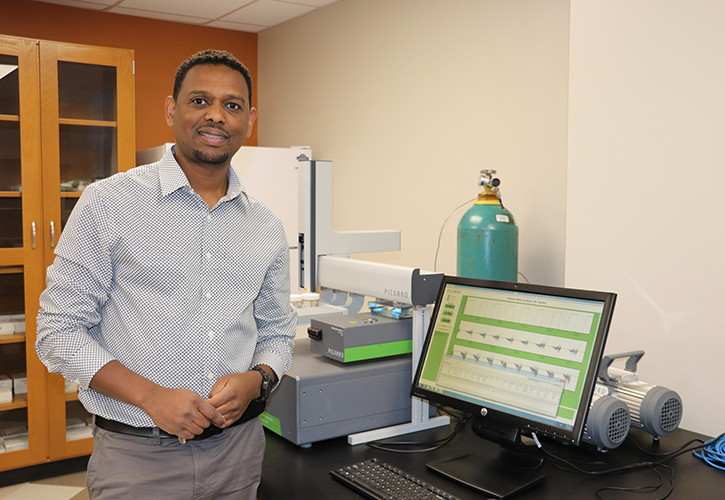College of Arts and Sciences Newsroom

National Science Foundation awards University of Dayton isotope geochemist $157K to study impact of extreme weather pattern shifts on early humans in East Africa
By Dave Larsen
The National Science Foundation awarded University of Dayton isotope geochemist Zelalem Bedaso a three-year, $156,776 grant to study seasonal rainfall variability over the last 200,000 years in East Africa to understand the impact of extreme weather on early humans and the ecosystems on which they depended.
Using fossil evidence and modern water isotope measurements, Bedaso and his research colleagues hope to understand the climate and environment in which humans survived and thrived. Their data also could indicate how this sensitive, water-limited region will respond to current and future climate change.
“Our general understanding of the paleoenvironment of that area in eastern Africa is in the last 5 million years there was a shift from a vegetated, forested environment into a more savannah kind of grassland — from a more wet to a dry climate,” said Bedaso, assistant professor of geology. “That’s what actually staged for early humans to evolve, because as the climate, environment and resources changed, that pressured early hominids to adapt to a different lifestyle.”
Bedaso is a co-principal investigator on the international study, which also includes a New York-based geoscientist and collaborators from Ethiopia and the Netherlands. His grant started Sept. 15 and runs through August 2024.
Co-principal investigator Catherine Beck, chair and associate professor of geosciences at Hamilton College in Clinton, New York, received a $132,318 National Science Foundation (NSF) grant, bringing the project’s total funding to $289,094.
Bedaso and Beck are from underrepresented groups in the geosciences and both have strong records of mentoring underrepresented students in their labs.
Nearly 30 undergraduate students from the University of Dayton, Hamilton College and Addis Ababa University in Ethiopia will participate in the research project. One student per year from both UD and Hamilton will join the team for summer research at the field site in the Omo-Turkana Basin in southern Ethiopia.
“This is an opportunity for cultural exchange, global learning and teamwork,” Bedaso said. “We will live in a tent for a couple of weeks. We eat together, we work together. Beyond academics, I think the students will learn how to live in that kind of environment.”
Located in a semi-arid environment of the East African Rift system, the Turkana Basin is one of the hottest regions globally. It is dominated by Lake Turkana, the world’s largest permanent desert lake, which is rich in resources that sustain habitation in this otherwise inhospitable region. However, the lake is sensitive to changes in seasonal moisture patterns.
Bedaso’s project aims to establish a fine resolution timescale of seasonal weather pattern shifts, such as wet versus dry periods in a given year. The researchers hope to connect those changes to significant points in human evolution, related to the availability of natural resources and fresh water.
“Those critical times in human evolution, when the way they walked or their brain size changed, actually align very well with the changing environment and climate,” Bedaso said. “So, a major shift in climate coincides with these major evolutionary milestones. That makes us think, maybe humans evolved because the climate, environment and resources are changing.”
Bedaso and Beck will work with Addis Ababa University environmental archeologist Alemseged Beldados and his students on the sedimentary record in southwestern Ethiopia, where one of the oldest remains of anatomically modern human was discovered. They will search for fossilized ostracods, microscopic crustacea also known as seed shrimp.
Beck will identify the different species of ostracods. Bedaso will then analyze their isotopic composition. “Their shells are calcium carbonates,” he said. “Using the carbon and oxygen isotopes in the carbonates, we interpret the environment and climate of the past.”
In addition, research colleague Jeroen van der Lubbe, assistant professor of geology and geochemistry at VU Amsterdam, will analyze the chemical composition of the sediment and fossil samples.
Six to nine undergraduates in Bedaso’s lab will analyze water isotopes from the site using state-of-the-art technology such as the Picarro Water Isotope Analyzer.
“Dr. Bedaso is an outstanding mentor for student research,” said Shuang-Ye Wu, professor and Department of Geology and Environmental Geosciences chair. “Over the years, he has mentored many students and their work has led to senior theses, student co-authored publications, and presentations at national and international conferences. This NSF grant will provide more opportunities and resources for our students to engage in significant scientific research, and prepare them better for a career in geosciences.”
For more information, visit the Department of Geology and Environmental Geosciences website.
